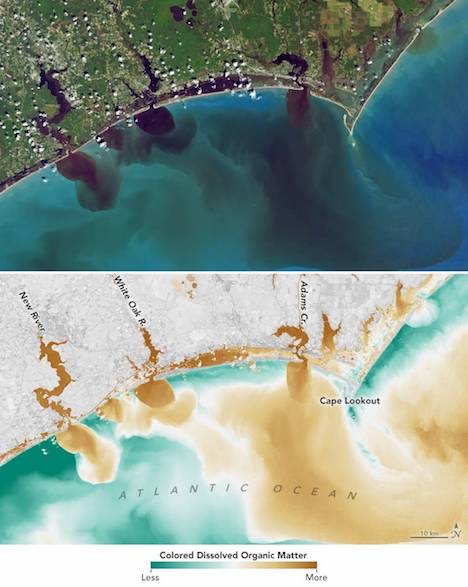A NASA satellite is tracking flooding in the Carolinas following Hurricane Florence, and its images show dark, polluted water flowing from rivers into the Atlantic Ocean. Nearly 8 trillion gallons of rain fell across North Carolina during the storm, according to the National Weather Service in Raleigh’s estimate. That rain led to catastrophic flooding across the state, and has polluted rivers, streams creeks and their outflows along the coast, NASA’s satellite images show.
One image captured on Sept. 19 shows the New River, White Oak River and Adams Creek south of Cape Lookout, shows deeply discolored water that appears dark brown — or even black. The color of the water in the image “reveals how soils, sediments, decaying leaves, pollution, and other debris have discolored the water in the swollen rivers, bays, estuaries, and the nearshore ocean,” according to NASA. “Organic matter—such as leaves, roots, or bark—contain pigments and chemicals (such as tannins) that can color the water when they dissolve. Depending on the amount of dissolved particles, the water in natural-color imagery can appear blue, green, yellow, or brown as the CDOM concentration increases,” NASA said. Some amount of that organic matter, or “tannins” and sediment are normal in Carolina waterways and is why many streams and rivers appear yellow, green or brown. But when there is more of that organic matter in waterways during or after major flood events, it’s can be considered pollution. It can lead to reduced water quality and could harm wildlife. This discoloration of Carolina waters from various pollutants has been seen in the wake of previous storms, and can lead to mass fish kills and other environmental effects, North Carolina scientists say. North Carolina researchers are linking hurricanes like Florence and Matthew to long-term effects of this discolored water to the deaths of aquatic life and water quality that can be unsafe for humans. As floodwaters from major storms move downstream, they carry those pollutants, which can create “dead zones” or areas where fish and other animals can’t live. “In the discharges after hurricanes Floyd and Matthew, these dead zones grew large enough to affect shellfish and finfish habitats for miles,” Paerl previously told the N&O. “Fish kills lasted for months.” Source URL |
